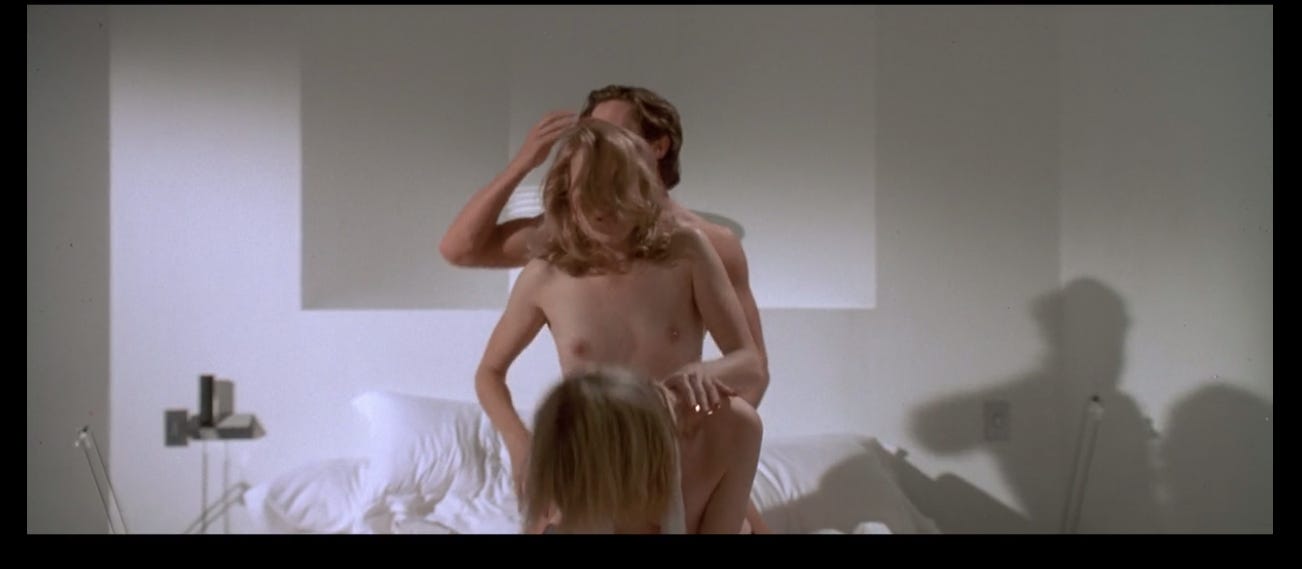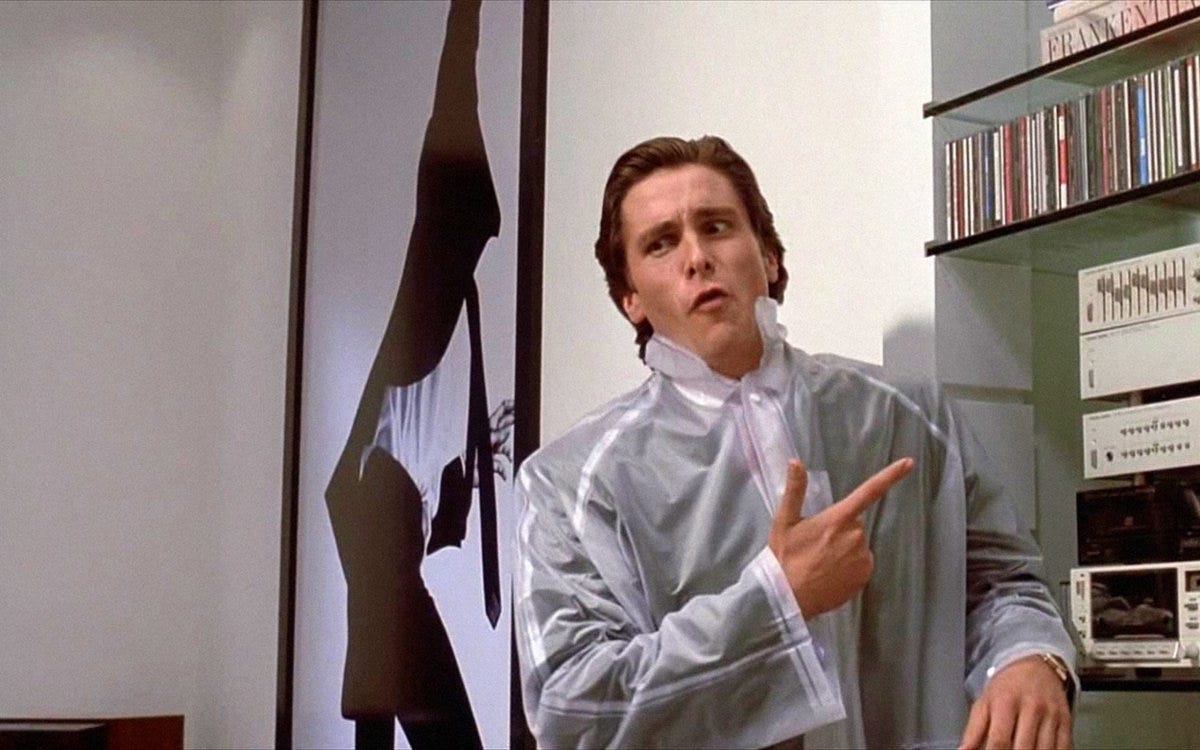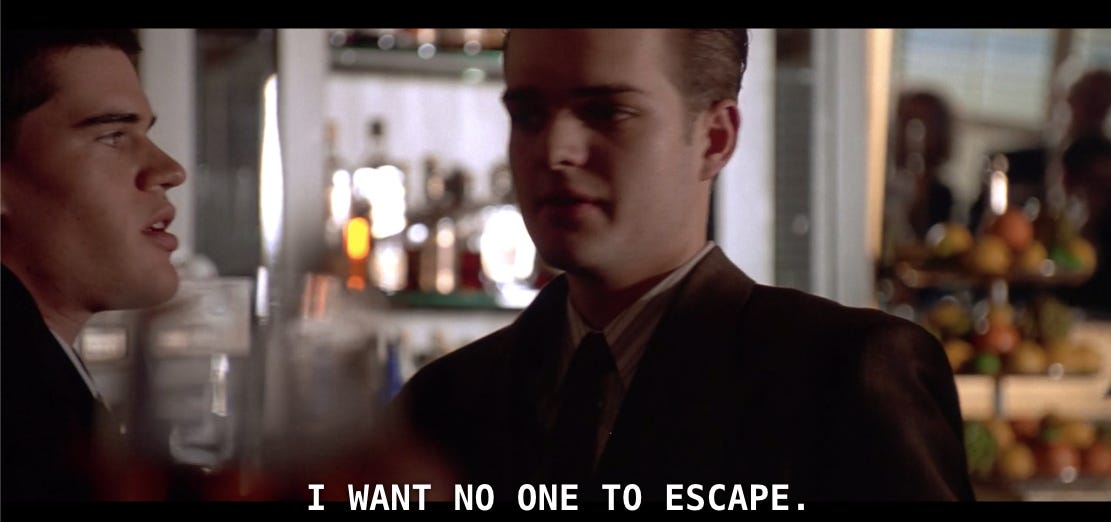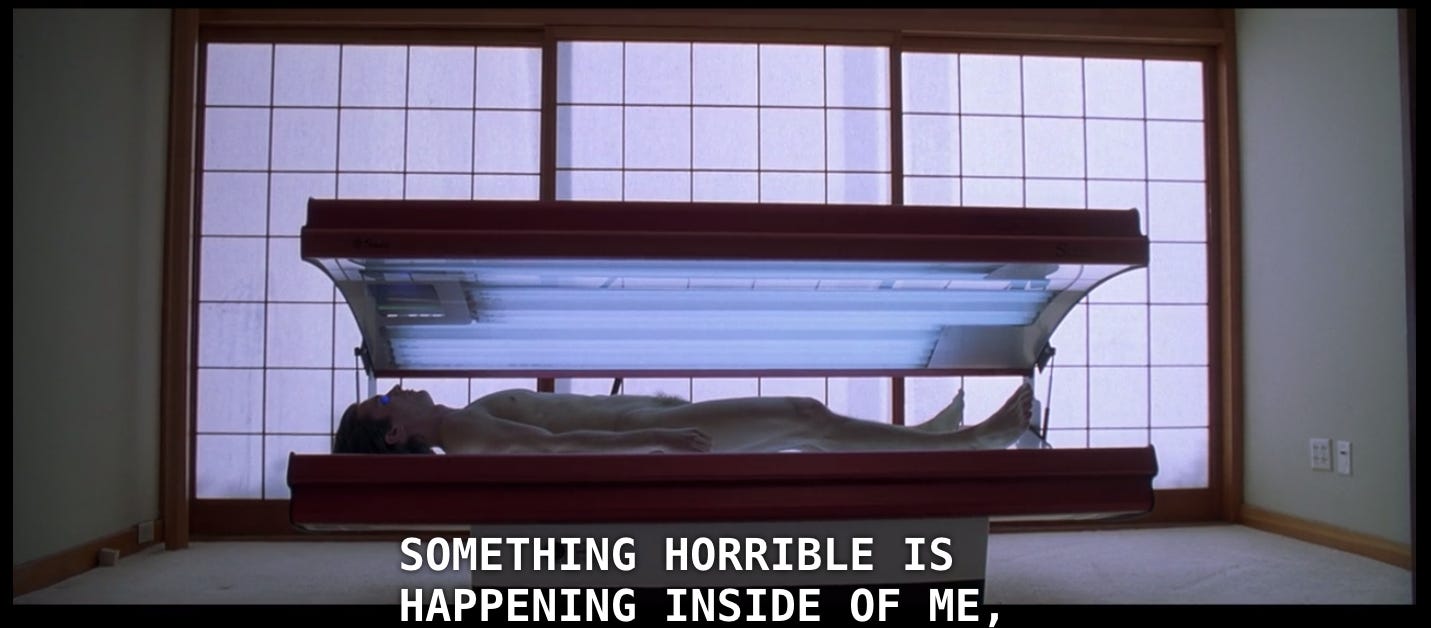For a while, it seemed like every straight guy I knew liked American Psycho, and they all liked it for the wrong reasons.
It was the Phil Collins scene. If you’ve seen the movie, you know it: Patrick Bateman hires two sex workers, and fucks them both, while taping the whole thing, but not before subjecting them to his extremely long, wrong, boring thoughts on Phil Collins. It’s his ritual before most killings, and during most sex. He recites a full, terrible record review, which he has never published anywhere, just so that the other person will have to pretend to care about his opinion.
There is a lot to love in this scene. I’ve always adored its take on how men use “taste” as a means of dominance; listening to and “respecting” a man’s opinions about music has become a heterosexual courtship ritual, so faking enthusiasm for a guy’s sub-Tumblr Phil Collins thoughts is a lot like faking an orgasm. I love how the camera lingers on the women’s faces, teasing out moments of boredom and sadness and irritation, and allowing us to infer whole, meaningful off-screen lives for them, despite the fact they have very little dialogue. There’s a whole biography here:

I even liked the sex itself, and how Harron takes care to keep Christian Bale’s nudity at the forefront. (I mean, Christian Bale’s nudity takes up a lot of screen time in this movie; his ass cheeks could get each get their own Best Supporting Actor nomination.) The sex is graphic, and pornographic, because Bateman is making porn, but Harron cuts away from that to focus on how this guy checks himself out in the mirror, what faces he makes and which poses he chooses to strike; this sex is a performance, but not for the women. Patrick Bateman is performing himself for himself, proving what kind of man he is. He doesn’t care if those women are having fun, just like he doesn’t care if they’re interested in what he has to say about Phil Collins, because the point isn’t pleasure, it’s power: He can make them pretend to want him. He can make them pretend to care.
That’s what I took away from the Phil Collins scene — and it is, I think, the rational takeaway, if you know that the scene was directed by a woman whose previous picture was a sympathetic biopic of Valerie Solanas. What straight guys took away from it was something different. They’d repeat Bateman’s commands to the women: Don’t stare at it, Christie, eat it! they’d cackle. They’d talk about the stack of girls. What I saw was the women’s boredom or sadness or fear. I saw their faces. What guys saw was this.

What this suggests to me is that American Psycho, more than most horror movies — more than most movies, period — comes down to a conflict between male and female gazes. What it’s about matters less than who is looking at it, and where we choose to look.
*
I may be one of the few people under age 40 who has actually read American Psycho from start to finish. Worse than that, I read it before its author Bret Easton Ellis went MAGA, back when people respected him and imputed good faith to his arguments and thought his misogyny and racism were “ironic,” so I couldn’t even talk about how fucking terrible his book was without getting into some kind of argument.
The basics of American Psycho — Wall Street finance bro who is, get this, a serial killer! — are laid out in that novel. In the right hands, the concept is interesting. It’s difficult to even remember this now, but it used to be that serial killers were either supernatural entities or hicks; the cannibal hillbillies in The Texas Chainsaw Massacre, or rural motel owner Norman Bates, or even suburban teen sociopaths Jason Voorhees and Michael Myers, do not strike us as sophisticated guys. Bateman, along with roughly contemporaneous monster Hannibal Lecter, brought the serial-killer story back to its roots in Dracula: The desire to kill is a desire to exercise dominance, so the ruling class kills us, because getting away with murder is just another privilege. We are cattle for the rich to consume.
I get the idea. It’s just that Bret Easton Ellis is too much of a talentless, coked-out prick to realize any of that idea’s potential.
I read American Psycho for the same reasons any horror fan does; it had a reputation as an unusually intense, grueling, violent book, and I wanted to see if I could handle it. I’d read other violent books for the same reasons, and some of them genuinely deserved that notoriety; Let’s Go Play At The Adams, for example, has floated in and out of print and circulated in bootlegged copies for years, precisely because it has a reputation as one of the most disturbing books ever written, and it’s true. It is. It’s crude, and pulpy, and not nearly as violent as Psycho, but the sheer nastiness and randomness of its violence still haunts me years later. I can remember, for instance, that when a group of children rapes and tortures our heroine to death (yep) they start by putting a red-hot poker on the sole of her foot.
The only thing I can remember about Bret Easton Ellis’ American Psycho is that a bunch of women got cut up. I don’t even remember how. I think there was one really gory scene with a rat, or maybe it was several of them (scenes, not rats) and I think maybe there was a little cannibalism somewhere in there. None of it stuck. None of it unsettled me or gave me new nightmares. Ellis wasn’t aiming for Let’s Go Play at the Adams-level notoriety with American Psycho. It wasn’t supposed to be pulp. This was supposed to be a serious, literary statement on the evils of conformity or Reagan or capitalism or something. Yet the result is so much worse than bad pulp fiction. It’s just a long, dull recitation of various methods for torturing women, all of them splatter-heavy and highly detailed, none of them particularly inventive or memorable, interspersed with some bad record reviews.
The crime of the book isn’t that it’s lowbrow, or that it’s violent, or even that it’s misogynist, though it is all those things. American Psycho just isn’t scary. It’s a horror novel written by someone who doesn’t understand or like horror, so it substitutes empty gross-outs for genuine scares, because the author can’t tell the difference. Yet somehow, Mary Harron’s American Psycho — the version of this story you’re actually familiar with — is one of the greatest horror movies of the 21st century, and one of the genre’s most piercingly relevant statements on conformity and capitalism and masculinity and all those things Bret Easton Ellis thought he was writing about.
The difference is not the plot. It’s the gaze. When Bret Easton Ellis wrote about Patrick Bateman, he felt he was Patrick Bateman: “He’s really infused with my own pain and what I was going through as a guy in my 20s,” he’s said. So that’s his cocaine, his nervous breakdown, his lust for money and status, his obsessive memorization of brands and restaurant names and products, his adoration of Donald Trump (Bateman thinks he sees Trump everywhere, and is excited every time) and, yes, his hatred for women, and maybe, just maybe, his desire to make women suffer. Ellis cannot help but sympathize with Bateman, the same way you cannot help but sympathize with yourself, even when you think you hate yourself. His great creation never achieves lift-off because it’s weighed down by authorial self-pity.
Harron views Bateman coldly, as an outsider. She doesn’t care what he’s “going through.” She’s interested in his narcissism, his hollow glitter, his pathetic fear that some other man might be better or cooler or richer than he is. She focuses in, pitilessly, on the smallness and weakness that fuels his abuse of power; her Bateman’s first “crazy” gesture is to call a bartender an “ugly bitch,” because she’s not allowed to talk back to him. Guys do that every day, to every woman who works behind a bar, because they’re cowards, and they can’t yell at other men, who might yell back or punch them in the mouth. That’s the kind of guy Patrick Bateman is; a coward. Harron never forgets it. She strips away Ellis’ “woe is me, I have too much money” monologues to examine what Bateman’s anger actually looks like to the people around him; racism, sexism, making fun of immigrants’ accents when they don’t get his order exactly right.
Ellis saw Bateman’s pain. Harron sees the pain Bateman inflicts on others. Ellis wanted to show us that Bateman was a victim, pushed to murder by the hollowness of his upper-class lifestyle or the materialistic culture of the ‘80s. Harron sees Bateman as a victimizer, someone whose vulnerability only makes him more toxic. Ellis and Harron agree on exactly one thing about Patrick Bateman: He can only re-affirm his masculinity by killing people with less power. In Ellis’ mind, this makes him an antihero. In Harron’s view, it makes him a loser. Ellis created Bateman to be a monster, but Harron sees him as a douchebag, and — even more cruelly — as a joke.
*
The key difference between American Psycho the book and American Psycho the movie is not that Harron’s version is scary. It’s that Harron’s version is funny. Intentionally so, I mean. Harron was able to save an atrociously bad piece of fiction by cutting through its thick layer of self-importance and Literary intent, and presenting it as pure slapstick comedy. It’s kind of astonishing; she pulled off the ending of The Producers, but on purpose, and in real life, and with a story about a guy who puts rats in people’s vaginas.
If that rat is “Springtime for Hitler,” Harron — whose Bateman is a creature of casual one-handed chainsaw throws and goofy pre-murder dances to Huey Lewis and the News, who washes his hands with his leather murder gloves still on and throws himself cool-guy finger-guns in the mirror while having sex — is the first audience member who laughed, the one who sent the rest of us rolling in the aisles.
Much of the movie’s comedy comes down to Christian Bale’s amazingly weird, malfunctioning-robot performance as Patrick Bateman. Plenty of people have praised that performance, and honestly, not enough can be said about it. Every single line read sounds like a slightly broken-down animatronic welcoming you to Disneyland. It’s like he’s not really sure how human bodies work and is just sort of flipping switches at random from inside the armature, making exaggerated, contextless versions of gestures he’s seen other humans make.
This was Christian Bale when he was a great actor, before he was a self-consciously, irritatingly Great Actor. The performance is better for being a little sloppy: In his most emotional scene, late in the movie, you can clearly hear that Patrick Bateman is crying with Bale’s own British accent. (“I killed that gehl! I killed a lot of gehls!”) Similarly, his physical comedy is over-the-top in a way that risks being obnoxious: Bale famously based the performance on Tom Cruise giving a late-night interview, and once you know that, boy, is the impression ever obvious. Then again, Patrick Bateman is exactly the kind of guy who would model his every word and move on Tom Cruise, so the gimmick works. Bale is clearly just dicking around, for most of this movie, and yet, it makes him magnetic. Even when he’s killing someone, he’s entertaining, because even when he’s killing someone, his face is doing this.

Yet American Psycho would not be a comedy unless Mary Harron set out to make it one. Her bravery and generosity may go unnoticed, but it was heroic work. Harron — working with a female screenwriter and frequent collaborator, Guinevere Turner — didn’t quiver in fear or cry her eyes out over Ellis’ misogyny. She simply refused to take it seriously. Ellis wrote a book about his pain and how it could only be assuaged by punishing women for being dumb bitches, and Harron, the director assigned to do this little manifesto justice, essentially rolled her eyes and made jerk-off motions at it for two hours. She didn’t just save us from Ellis’ awful book, she did the man himself a favor: In finding comedy where there was only self-pity, Harron gave American Psycho a better name and a more enduring place in the canon than Bret “No Good Female Directors” Ellis could ever manage for himself.
*

It’s a banal observation, but Patrick Bateman is a very 2019 kind of monster. It’s not just about his Trump obsession, although that does stand out. (Both of the president’s sons, as many have noted, kind of look like Bateman.) It’s not just about the fact that he is an evil Wall Street dude, the living embodiment of the corrupt and bloodthirsty one percent; again, that goes all the way back to Dracula. Aristocrats have always been monsters. It’s about his hollowness, his essential performativity. As the camcorder in that sex scene should tell you, Patrick Bateman doesn’t think he exists unless he is being looked at. He cultivates every moment of his life for an Instagram feed that doesn’t yet exist. His self-esteem is purely a matter of social status, being seen at the right places with the right people and the right objects. His desire to love or value himself is wholly mediated through capitalism, coming in the form of spa treatments and expensive consumer products that substitute for “self-care;” his opening monologue is an Into The Gloss Top Shelf where he takes us through every step of his skin care routine.
Patrick Bateman was the horizon we were all moving toward, and we didn’t realize it until he swallowed us whole. American Psycho is a classic because it remains prescient and relevant; no longer a movie about “the ‘80s,” but increasingly a movie about who we are and how we live right now.

It’s also a movie about how women look at men, and how men look at women or each other — another very 2019 problem. Being hollow, Bateman cannot help but see other people as hollow, too. Women (sex workers, girlfriends, even his fiancé) are just another set of consumer goods, valued in terms of how they look, or how they make him look. Yet all the time, as Patrick Bateman is looking at those women, or regarding his own grandiose and needy self, Harron is looking at him. Her gaze pushes him out of the drivers’ seat, rendering him a spectacle and an object to be examined. There’s a reason that Bateman is naked so often in this movie, and it’s not just that the young Christian Bale was shockingly beautiful. It’s because a naked man is a helpless man. He’s exposed, he has no privacy, nowhere to hide from our gaze. Patrick Bateman renders women helpless by killing them, but Harron renders Bateman helpless simply by seeing him. It is, in the end, the more resonant exercise of power.

Bret Easton Ellis created Patrick Bateman to tell us about his pain. But we’ve heard a lot about men’s pain, in the past few hundred years. Men never stop telling us about it. I don’t think the field is totally exhausted — I submit to you that there are as many as five, even six men who can write well on the topic of their own emotions — but I think what men need, in most cases, is not to explain how they feel, but to understand what their feelings look like to everyone else. You can be eaten alive by your own interiority; you can be swinging a chainsaw into some girl’s face and still believe the real tragedy is your own hurt feelings. That self-absorption is what true evil is. Patrick Bateman — and Donald Trump, and Bret Easton Ellis — know what it’s like to live that kind of evil. The rest of us know what it’s like to survive it. When we flip the angle on men’s stories about themselves, to see how those stories look to the other people in them, we find the truth of the matter. That’s the only place any good story can begin.
—
American Psycho is available to stream on Netflix.
This Spooky Season, I’m trying to cover some of the big, canonical classics of lady horror. If there’s anything else you’d like me to cover, please nominate it by responding to this e-mail or Tweeting at me.